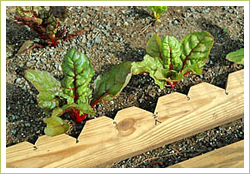How far should you space your plants?
Joe Lamp’l Executive Producer and Host | Growing a Greener World

When it comes to getting the most from your limited garden space, it would seem logical to pack it in. And for many plants, especially flowering annuals, this strategy can reward you with a season-long ocean of color. However, for other plants, especially edibles, I take the opposite approach — and for good reason. Unlike ornamentals that typically flower across the top or crown of the plant, edibles usually flower and fruit along or within the plant. So why is that important?
A bountiful harvest is only possible when plants are in peak condition. Below ground, that means compost rich, well-drained soil. Above ground that means plenty of sunlight to bathe the entire plant. And one more thing: good air circulation is important for nearly all plants but especially edibles, to minimize potential disease pathogens from gaining ground on leaf surfaces. So when plants have the benefit of plenty of light and air, those risks are greatly reduced. Providing plenty of space between plants allows that to happen.
Conversely, when plants are denied those basic requirements, critical energy needed to produce flowers and subsequent fruit is diverted to seeking sufficient light before they can be productive. Also, if diseases take hold, the plant now must use energy to defend itself or if it succumbs, there won’t be as much energy to thrive. And that happens when there’s not enough spacing.
Yet as with all things, there are exceptions to every rule. I know there are many Square Foot Gardening disciples out there. And to founder Mel Bartholomew’s credit, he’s inspired many a gardener to pack in their plants with great success. For plants, such as carrots, beets, parsnips, onions and garlic, where most of the work happens below ground, a cozier planting is perfectly acceptable.
And for every plant under the sun, there are nearly unlimited resources to provide specific, time-tested advice for the optimal spacing. You’ll find it in places such as seed packets, plant tags, and on the web through trusted online sources including one of my go-to favorites for annuals and ornamentals, My Garden Designer from Burpee Home Gardens. It’s reassuring to know there are many trusted sources for such advice. But when it comes to gardening, experience is always the best teacher and pushing the envelope offers the very best lessons, with little downside risk.